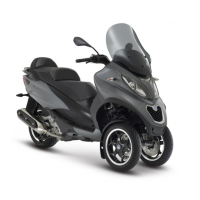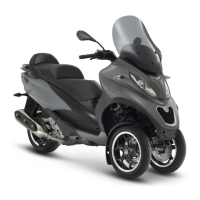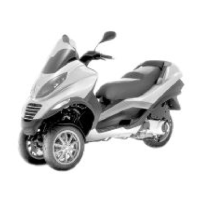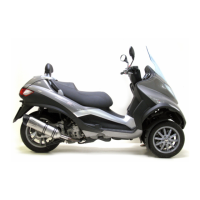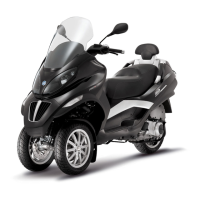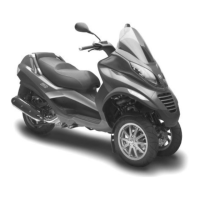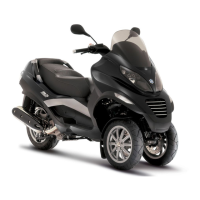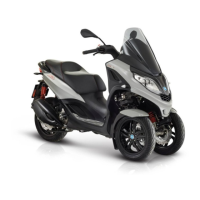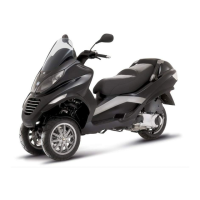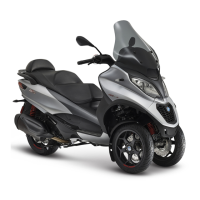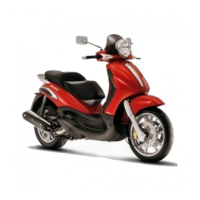Do you have a question about the PIAGGIO MP3 500 ie SPORT Business LT (2011) and is the answer not in the manual?
General safety guidelines for vehicle maintenance operations.
Rules for using original parts, tools, and proper procedures during maintenance.
Information on identifying the chassis and engine prefixes of the vehicle.
Details on the vehicle's weight, dimensions, wheelbase, length, and track.
List of specialized tools with store codes and descriptions for maintenance.
Step-by-step guide for adjusting ring nuts on side headstocks of front suspension.
Scheduled maintenance table with intervals and required actions (check, clean, adjust, lubricate, replace).
Procedure for checking ignition advance using stroboscopic light and diagnostic tester.
Instructions for removing and installing spark plugs, including electrode gap specification.
Procedure for checking and replacing rear hub oil.
Procedure for cleaning and replacing the air filter element.
Information on engine oil usage, quantity, and replacement procedure.
Instructions for checking and topping up engine oil level.
Procedure for changing the engine oil filter and necessary precautions.
Explanation of the oil pressure warning light and when to check oil level.
Procedure for checking ignition timing using reference marks and diagnostic tester.
Procedure for adding engine coolant and checking coolant level.
Description of braking system components and level checks for front, rear, and integral systems.
Instructions for topping up front, rear, and integral brake fluid reservoirs.
Procedure for adjusting headlight beams according to standards.
Troubleshooting for engine issues like excessive oil consumption, exhaust smoke, and lubrication pressure.
Troubleshooting for clutch performance and braking system issues.
Troubleshooting for heavy steering, excessive play, and noisy suspension systems.
Troubleshooting steps for identifying and fixing suspension oil leaks.
Key to identify numbered components in the electrical diagrams.
Visual identification and location of electrical components on the vehicle.
Detailed description of the immobilizer system, its components, and diagnostic codes.
Information on fuse boxes, their locations, and the function of each fuse.
Diagram and labels for all indicators and controls on the dashboard.
Steps for removing the exhaust assembly, including disconnection of the lambda probe.
Step-by-step procedure for removing the engine from the vehicle.
Technical details of the engine including capacity, bore, stroke, compression ratio, and timing system.
Details on automatic transmission components and removal/installation procedures.
Steps for removing the clutch assembly using special tools and wrenches.
Procedure for splitting crankcase halves after checking crankshaft axial clearance.
Technical specifications for sump capacity, recommended engine oil, oil pump, by-pass, and pre-filter.
Procedure for checking oil pressure and oil consumption.
Description of the integrated injection and ignition system, timing, and control parameters.
Important precautions to follow before fixing injection system parts or performing functional checks.
Hints for troubleshooting MIU system failures, focusing on connections and common causes.
Procedures for diagnosing engine start-up issues and engine stopping at idle.
Description of the fuel supply circuit components and their function.
Procedure for resetting the throttle valve position signal (TPS reset).
Electrical diagram and load specifications for the lambda probe.
Operations related to the front suspension, including wheel and hub overhaul.
Procedures for removing and refitting the handlebar, including torque specifications.
Procedures for using the palmtop to reset the suspension system and adjust the gear motor.
Procedures and tools for checking and adjusting wheel alignment.
Operations related to the rear suspension, including wheel removal and swing-arm.
Procedures for removing and refitting the swing-arm, including silent-blocks.
Procedures for removing and refitting shock absorbers, including torque specifications.
Diagrams and labels for brake system pipe fittings.
Procedure for removing and refitting the rear brake calliper.
Procedure for removing and refitting the front brake callipers.
Procedure for removing and refitting the rear brake disc, including inspection.
Procedure for removing and refitting the front brake disc, including inspection.
Procedure for removing and refitting front brake pads, including minimum thickness.
Procedure for removing and refitting rear brake pads, including minimum thickness and torque.
Procedure for bleeding the rear combined braking system.
Procedure for bleeding front brake system components.
Diagram illustrating the forced circulation cooling system and its components.
Specifications for cooling system capacity, fluid, sealing pressure, thermostat, electric ventilation, water pump, radiator, and expansion tank.
Procedure for checking the electric fan control circuit using a diagnostic tester.
Procedure for checking the cooling system's sealing under pressure and temperature.
Instructions for preparing the coolant mixture and filling the system.
Information on water pump noise or liquid loss, and preliminary operations for overhaul.
Procedures for raising the saddle, removing the cover, and disconnecting the rider presence sensor.
Steps for removing the front handlebar cover, legshield, and instrument panel.
Steps for removing the radiator cover, wheelhouses, and headlight assembly.
Procedure for removing the frame central cover, including tank cap and cable disconnection.
Steps for removing the headlight assembly, spoiler, and leg shield back plate.
Checklist for aesthetic appearance, including paintwork, plastics, scratches, and dirt.
Visual check of tightening torques on front and rear suspension components.
Pre-delivery checks for battery, switches, lights, and other electrical components.
Checks for hydraulic brake fluid, roll lock fluid, rear hub oil, and engine coolant/oil levels.
Procedures for conducting a road test, covering cold start, controls, and performance checks.
Functional checks for hydraulic braking, clutch, engine, and other vehicle systems.
Repair times for engine components like engine to chassis replacement.
Repair times for crankcase components such as oil seals, crankcase, and gaskets.
Repair times for crankshaft and countershaft replacement.
Repair times for cylinder/piston, piston rings, and chain tensioner replacement.
Repair times for cylinder head components like valves, gaskets, and sensors.
Repair times for flywheel cover, oil filter, by-pass valve, and water pump components.
Repair times for clutch, driven pulley, and clutch bell replacement.
Repair times for oil pump overhaul, belt/chain replacement, and chain guide pads.
Repair times for geared reduction unit, cover, oil, wheel axle, and hub bearings.
Repair times for driving pulley components like half-pulley, belt, rollers, and anti-flapping roller.
Repair times for transmission cover components, air intake, and bearings.
Repair times for water pump cover, rotor, sleeve, and fan replacement.
Repair times for starter motor, pinion, driven gearing, and cable assembly.
Repair times for flywheel magneto components like rotor, stator, flywheel, and freewheel.
Repair times for intake manifold, injector, and control unit replacement.
Repair times for muffler, exhaust manifold, muffler guard, and lambda probe replacement.
Repair times for air filter box, air filter, and cleaner/throttle body unions.
Repair times for chassis components like front, rear, and central chassis parts, and footrest supports.
Repair times for legshield components like headlight frame, legshield, and covers.
Repair times for side fairing components like chassis cover, rear fairing, and side aprons.
Repair times for front suspension components like steering tube, wheel bearings, and shock absorber.
Repair times for cooling system components like radiator, expansion tank, water pump, and fan.
Repair times for braking system components like piping, callipers, pads, and discs.
Repair times for tilt mechanism components like steering clearance, steering tube, and parallelogram arms.
Repair times for geared motor components like voltage regulator, HV coil, and control unit.
General safety guidelines for vehicle maintenance operations.
Rules for using original parts, tools, and proper procedures during maintenance.
Information on identifying the chassis and engine prefixes of the vehicle.
Details on the vehicle's weight, dimensions, wheelbase, length, and track.
List of specialized tools with store codes and descriptions for maintenance.
Step-by-step guide for adjusting ring nuts on side headstocks of front suspension.
Scheduled maintenance table with intervals and required actions (check, clean, adjust, lubricate, replace).
Procedure for checking ignition advance using stroboscopic light and diagnostic tester.
Instructions for removing and installing spark plugs, including electrode gap specification.
Procedure for checking and replacing rear hub oil.
Procedure for cleaning and replacing the air filter element.
Information on engine oil usage, quantity, and replacement procedure.
Instructions for checking and topping up engine oil level.
Procedure for changing the engine oil filter and necessary precautions.
Explanation of the oil pressure warning light and when to check oil level.
Procedure for checking ignition timing using reference marks and diagnostic tester.
Procedure for adding engine coolant and checking coolant level.
Description of braking system components and level checks for front, rear, and integral systems.
Instructions for topping up front, rear, and integral brake fluid reservoirs.
Procedure for adjusting headlight beams according to standards.
Troubleshooting for engine issues like excessive oil consumption, exhaust smoke, and lubrication pressure.
Troubleshooting for clutch performance and braking system issues.
Troubleshooting for heavy steering, excessive play, and noisy suspension systems.
Troubleshooting steps for identifying and fixing suspension oil leaks.
Key to identify numbered components in the electrical diagrams.
Visual identification and location of electrical components on the vehicle.
Detailed description of the immobilizer system, its components, and diagnostic codes.
Information on fuse boxes, their locations, and the function of each fuse.
Diagram and labels for all indicators and controls on the dashboard.
Steps for removing the exhaust assembly, including disconnection of the lambda probe.
Step-by-step procedure for removing the engine from the vehicle.
Technical details of the engine including capacity, bore, stroke, compression ratio, and timing system.
Details on automatic transmission components and removal/installation procedures.
Steps for removing the clutch assembly using special tools and wrenches.
Procedure for splitting crankcase halves after checking crankshaft axial clearance.
Technical specifications for sump capacity, recommended engine oil, oil pump, by-pass, and pre-filter.
Procedure for checking oil pressure and oil consumption.
Description of the integrated injection and ignition system, timing, and control parameters.
Important precautions to follow before fixing injection system parts or performing functional checks.
Hints for troubleshooting MIU system failures, focusing on connections and common causes.
Procedures for diagnosing engine start-up issues and engine stopping at idle.
Description of the fuel supply circuit components and their function.
Procedure for resetting the throttle valve position signal (TPS reset).
Electrical diagram and load specifications for the lambda probe.
Operations related to the front suspension, including wheel and hub overhaul.
Procedures for removing and refitting the handlebar, including torque specifications.
Procedures for using the palmtop to reset the suspension system and adjust the gear motor.
Procedures and tools for checking and adjusting wheel alignment.
Operations related to the rear suspension, including wheel removal and swing-arm.
Procedures for removing and refitting the swing-arm, including silent-blocks.
Procedures for removing and refitting shock absorbers, including torque specifications.
Diagrams and labels for brake system pipe fittings.
Procedure for removing and refitting the rear brake calliper.
Procedure for removing and refitting the front brake callipers.
Procedure for removing and refitting the rear brake disc, including inspection.
Procedure for removing and refitting the front brake disc, including inspection.
Procedure for removing and refitting front brake pads, including minimum thickness.
Procedure for removing and refitting rear brake pads, including minimum thickness and torque.
Procedure for bleeding the rear combined braking system.
Procedure for bleeding front brake system components.
Diagram illustrating the forced circulation cooling system and its components.
Specifications for cooling system capacity, fluid, sealing pressure, thermostat, electric ventilation, water pump, radiator, and expansion tank.
Procedure for checking the electric fan control circuit using a diagnostic tester.
Procedure for checking the cooling system's sealing under pressure and temperature.
Instructions for preparing the coolant mixture and filling the system.
Information on water pump noise or liquid loss, and preliminary operations for overhaul.
Procedures for raising the saddle, removing the cover, and disconnecting the rider presence sensor.
Steps for removing the front handlebar cover, legshield, and instrument panel.
Steps for removing the radiator cover, wheelhouses, and headlight assembly.
Procedure for removing the frame central cover, including tank cap and cable disconnection.
Steps for removing the headlight assembly, spoiler, and leg shield back plate.
Checklist for aesthetic appearance, including paintwork, plastics, scratches, and dirt.
Visual check of tightening torques on front and rear suspension components.
Pre-delivery checks for battery, switches, lights, and other electrical components.
Checks for hydraulic brake fluid, roll lock fluid, rear hub oil, and engine coolant/oil levels.
Procedures for conducting a road test, covering cold start, controls, and performance checks.
Functional checks for hydraulic braking, clutch, engine, and other vehicle systems.
Repair times for engine components like engine to chassis replacement.
Repair times for crankcase components such as oil seals, crankcase, and gaskets.
Repair times for crankshaft and countershaft replacement.
Repair times for cylinder/piston, piston rings, and chain tensioner replacement.
Repair times for cylinder head components like valves, gaskets, and sensors.
Repair times for flywheel cover, oil filter, by-pass valve, and water pump components.
Repair times for clutch, driven pulley, and clutch bell replacement.
Repair times for oil pump overhaul, belt/chain replacement, and chain guide pads.
Repair times for geared reduction unit, cover, oil, wheel axle, and hub bearings.
Repair times for driving pulley components like half-pulley, belt, rollers, and anti-flapping roller.
Repair times for transmission cover components, air intake, and bearings.
Repair times for water pump cover, rotor, sleeve, and fan replacement.
Repair times for starter motor, pinion, driven gearing, and cable assembly.
Repair times for flywheel magneto components like rotor, stator, flywheel, and freewheel.
Repair times for intake manifold, injector, and control unit replacement.
Repair times for muffler, exhaust manifold, muffler guard, and lambda probe replacement.
Repair times for air filter box, air filter, and cleaner/throttle body unions.
Repair times for chassis components like front, rear, and central chassis parts, and footrest supports.
Repair times for legshield components like headlight frame, legshield, and covers.
Repair times for side fairing components like chassis cover, rear fairing, and side aprons.
Repair times for front suspension components like steering tube, wheel bearings, and shock absorber.
Repair times for cooling system components like radiator, expansion tank, water pump, and fan.
Repair times for braking system components like piping, callipers, pads, and discs.
Repair times for tilt mechanism components like steering clearance, steering tube, and parallelogram arms.
Repair times for geared motor components like voltage regulator, HV coil, and control unit.
| Displacement | 493 cc |
|---|---|
| Transmission | Automatic CVT |
| Fuel System | Electronic fuel injection |
| Fuel Capacity | 12 liters |
| Seat Height | 790 mm |
| Front Tire | 120/70-14 |
| Rear Tire | 140/60-14 |
| Width | 775 mm |
| Engine Type | Single cylinder, 4-stroke |
| Cooling | Liquid |
| Brakes | Hydraulic disc |
| Rear Brake | 1 disc |
| ABS | Available |
| Front Brake | Dual 240 mm discs |
